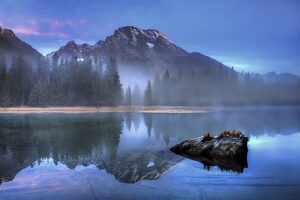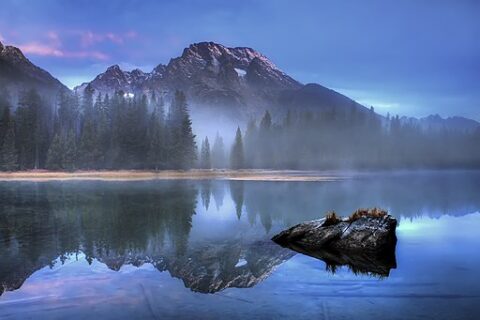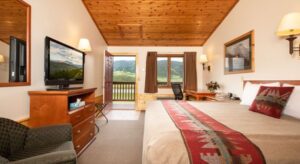Native Americans in Jackson Hole

It’s not Native American Heritage Month yet (that’s in November), but seeing as how we live on native land for more than just one month a year, we figured it was all right to dedicate a post to a topic that’s both interesting and relevant: the history of NativeAmericans in Jackson Hole.  Mount Moran and String Lake[/caption] The area now called Grand Teton National Park has hosted human inhabitants for a long, long time. Evidence exists that people have lived here for as long as 11,000 years ago, right after the last ice age. Over time those inhabitants settled into distinct tribes. According to the Wyoming state website, those include the Arapaho, Arikara, Bannock, Blackfeet, Cheyenne, Crow, Gros Ventre, Kiowa, Nez Perce, Sheep Eater, Sioux, Shoshone, and Ute tribes. Each tribe to dwell in the area made its mark, respecting and utilizing the area’s many natural features. The image perpetuated by early white settlers was one of superstitious natives who avoided the hot springs out of fear, but that couldn’t have been further off. For instance, the Mountain Shoshone used the region's geothermal features to help them make hunting bows. The relationship between the indigenous people and the land they lived on persisted for centuries.
Mount Moran and String Lake[/caption] The area now called Grand Teton National Park has hosted human inhabitants for a long, long time. Evidence exists that people have lived here for as long as 11,000 years ago, right after the last ice age. Over time those inhabitants settled into distinct tribes. According to the Wyoming state website, those include the Arapaho, Arikara, Bannock, Blackfeet, Cheyenne, Crow, Gros Ventre, Kiowa, Nez Perce, Sheep Eater, Sioux, Shoshone, and Ute tribes. Each tribe to dwell in the area made its mark, respecting and utilizing the area’s many natural features. The image perpetuated by early white settlers was one of superstitious natives who avoided the hot springs out of fear, but that couldn’t have been further off. For instance, the Mountain Shoshone used the region's geothermal features to help them make hunting bows. The relationship between the indigenous people and the land they lived on persisted for centuries.
Stan Petersen, CC BY-SA 4.0 <https://creativecommons.org/licenses/by-sa/4.0>, via Wikimedia Commons
Thousands of years of history
[caption id="attachment_2638" align="alignright" width="480"] Mount Moran and String Lake[/caption] The area now called Grand Teton National Park has hosted human inhabitants for a long, long time. Evidence exists that people have lived here for as long as 11,000 years ago, right after the last ice age. Over time those inhabitants settled into distinct tribes. According to the Wyoming state website, those include the Arapaho, Arikara, Bannock, Blackfeet, Cheyenne, Crow, Gros Ventre, Kiowa, Nez Perce, Sheep Eater, Sioux, Shoshone, and Ute tribes. Each tribe to dwell in the area made its mark, respecting and utilizing the area’s many natural features. The image perpetuated by early white settlers was one of superstitious natives who avoided the hot springs out of fear, but that couldn’t have been further off. For instance, the Mountain Shoshone used the region's geothermal features to help them make hunting bows. The relationship between the indigenous people and the land they lived on persisted for centuries.
Mount Moran and String Lake[/caption] The area now called Grand Teton National Park has hosted human inhabitants for a long, long time. Evidence exists that people have lived here for as long as 11,000 years ago, right after the last ice age. Over time those inhabitants settled into distinct tribes. According to the Wyoming state website, those include the Arapaho, Arikara, Bannock, Blackfeet, Cheyenne, Crow, Gros Ventre, Kiowa, Nez Perce, Sheep Eater, Sioux, Shoshone, and Ute tribes. Each tribe to dwell in the area made its mark, respecting and utilizing the area’s many natural features. The image perpetuated by early white settlers was one of superstitious natives who avoided the hot springs out of fear, but that couldn’t have been further off. For instance, the Mountain Shoshone used the region's geothermal features to help them make hunting bows. The relationship between the indigenous people and the land they lived on persisted for centuries. The arrival of the Europeans
Like native peoples all over the hemisphere, the people of the land now called Jackson Hole found their way of life challenged with the arrival of European settlers in the Americas. At first, they found ways to adapt. Some natives, like the famous Shoshone woman Sacagawea, guided the Europeans exploring their homelands. Another Shoshone guide, Togote, guided the expedition of Captain William Jones in 1873. When Jones was concerned that the group wouldn’t be able to enter Yellowstone from the east due to impassable mountains, Togote led them on a different route, through led them through Blondie Pass, over the Owl Creek mountains, through Sylvan Pass in the Absarokas, and finally into Yellowstone. But by the mid-1800s, disease spread through North America, reducing native populations by as much as 90%. Scarce game made life even harder for the surviving natives. Facing existential threats from all sides, the native population was eventually forced into reservations.The massacre
On July 13, 1895, a group of Bannocks were hunting elk where Granite Creek and the Hoback River met. They awoke to find themselves surrounded by 27 armed white men, who accused them of violating Wyoming’s new hunting laws. The settlers led the Bannocks toward jail, but the natives, fearing for their lives, scattered into the woods. The white settlers opened fire. Several died; one old man was shot four times in the back. Back in Cheyenne, the news read, “Settlers Massacred: At Least Sixteen Families Butchered in Jackson Hole by the Red Devils.” National news reported that white settlers all over Jackson Hole had been wiped out by marauding parties of Indians. In fact, not a single white was harmed. In fact, the Bannock survivors had made their way back to Fort Hall without attacking a soul. The massacres supposedly happening all over the state were, to borrow a more modern phrase, fake news. When the US government sent five companies to pacify the hostile Indians, they found no evidence of the slaughter they had been led to expect. Even the general in charge wrote, “I do not consider the Indians to blame for the Jackson Hole affair.”Native Americans today
The history of Native Americans in Jackson Hole, like such histories all over the country, is a sad one. But it’s not over. Rather than being consigned to the past, the Native American culture lives on. Visit one of Jackson’s Native American jewelry shops. Attend a yearly Teton Powwow event (in May) to immerse yourself in the culture of the first peoples. Visit the Jackson Hole Historical Society and Museum. There’s no shortage of ways to learn about the people whose land you’re visiting or living on. This post is brought to you by Flat Creek Inn. Ryan Kunz is a copywriter and freelance writer who writes on a variety of topics, including media, the outdoors, and whatever else strikes his fancy.Stan Petersen, CC BY-SA 4.0 <https://creativecommons.org/licenses/by-sa/4.0>, via Wikimedia Commons

